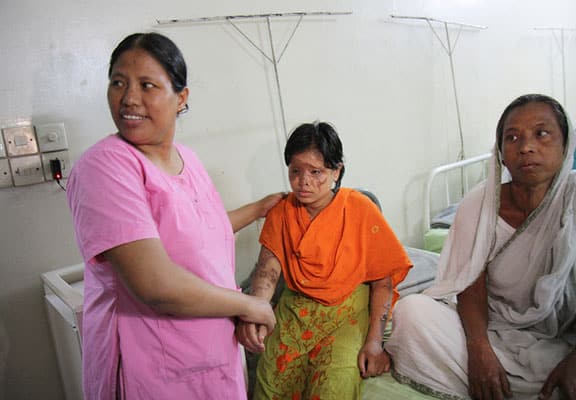

Credit: Narayan Nath/FCO/Department for International Development on Flickr, under Creative Commons (CC BY 2.0)
BANGALORE, India (WOMENSENEWS)-Simi Rao, 37, a former school teacher and mother of two, has been in and out of the hospital since Feb. 21, the day her husband, who runs a restaurant, threw acid on her.
Her crime was that she was beautiful and he resented the admiring glances she got. With severe damage to her neck and hand, she has had extensive surgery over the last eight months. Her parents are funding her medical expenses but cannot really afford the huge costs. Speaking from her hospital bed, she says plaintively, “I need more treatment, I need a job, but the government has done nothing despite the Supreme Court directive of July 2013.”
That historic ruling came from the apex court, which ordered that sales of acid be restricted to those who provide proof of age and identity and that all sales records be maintained and forwarded periodically to the police. The Supreme Court gave the government three months to implement these new rules, a deadline that expired on Oct. 16.
“Nothing has been done,” says Sushma Varma, trustee of the Campaign and Struggle Against Acid Attacks on Women, a coalition of over 20 women's groups. “The state governments that are responsible for implementing the court's orders say they have ‘yet to finalize their policies.'”
On Oct. 20, the parents of Preeti Rathi, 23, who died in a Mumbai hospital on June 1, led a group outside the home minister's office in Delhi protesting governmental apathy towards victims of acid attacks. The minister's response: since the death occurred in Mumbai, the state government of Maharashtra (of which Mumbai is the capital) was responsible for taking action.
This, women's activists say, is typical of the administration's “passing-the-buck” response.
Rathi, who was attacked on May 2 by a stranger, was put on a ventilator after her lungs and respiratory system collapsed. She lingered for a month before dying.
‘Waiting for Guidelines'
Kavitha Mannikeri, secretary of the Karnataka State Commission for Women, says her organization is “waiting for guidelines from the government.” The Karnataka State Commission for Women has not had a chairperson since March.
In the meantime, the Ministry of Home Affairs, which oversees state policies, has extended the deadline to November to give state administrators more time. Acid victims' rights are clearly not a priority for politicians preparing for nationwide general elections in early 2014.
The Supreme Court also decreed that victims should be given about $5,000 compensation, with part of it to be paid within a fortnight of the attack. Eight months after being attacked, Rao has not received anything.
In making its ruling the court noted that over 1,000 women are victims of acid attacks annually.
Victims are left deeply scarred for life not only physically, with muscles and internal organs destroyed, but also mentally since their gruesome appearance, with facial deformities, makes them outcastes in society. It scares even their own children (as one victim put it) and destroys their chances of employment when they wish to eke out a living on their own.
Donna Fernandes, one of the founders of Vimochana, a leading group of women's rights activists in Bangalore, in Karnataka state in south India, has been assisting in Rao's case. She says about 60 of 87 victims in Karnataka state have received any financial compensation since 2007.
Commenting on Rao's case, Fernandes says: “Being beautiful is a problem, but not being beautiful is also a problem in finding employment, as most victims find.”
Most victims wear a burka to hide their hideous scars, but even so, finding jobs is difficult because of their disability. Unlike other attacks, acid also eats away deeply into the flesh. Recovery and reconstructive surgery is prolonged and costly.
It is difficult even to get proper estimates of the number of victims, since the police record such attacks under a general category in the penal code of “attempt to murder.”
Under an amendment to the Criminal Law Ordinance, proposed in July 2013, acid attacks are now to be booked under separate sections (326A and B). Passing laws is one thing, implementing them in spirit to ensure justice is, however, another.
Diverse Cases
In the meantime, stories of women suffering from acid burns abound and span diverse backgrounds; Hindu, Muslim and Christian, some poor, some affluent.
Haseena, 19, is a computer operator in south India. Rubi, 26, lives in central India. Pragya, 22, was on her way to Delhi for a job interview. Sruti is 16. Sarojini is 19. This list, just a glimpse of cases available on the record, is long.
They are all victims of acid attacks by men whose advances they spurned. Rubi died on July 21, three days after the Supreme Court order.
In cases like Rao's, a husband throws acid on a woman, to “punish” her, either because she is too attractive and the husband suspects her “fidelity” if she speaks to other men, or because she is “disobedient” and insists on going out to work despite his orders to stay home as a housewife.
Pragya's “crime” was rejecting a marriage proposal from a distant relative and choosing to marry someone else.
Geeta, another victim, was “punished” because she refused to obey her husband's order to give up her job and stay home. Her husband, an alcoholic, gave her no money to feed the family, so she saw no alternative to working. Her son dropped out of the seventh grade to look after her after the attack, which left her blinded in one eye. She also has an aged mother to care for.
Haseena had spurned her employer's advances so he threw sulphuric acid on her, disfiguring her face so badly that she has had 35 reconstructive operations.
Rachna, 26, met Pradeep, a gym trainer, via Facebook. They fell in love and got married in August 2012. On June 26, 2013, he took her out for a drive, stopped the car at a deserted spot, threw acid on her face and drove off, leaving her screaming for help. He suspected her fidelity.
Insufficient Compensation
Even if survivors of these attacks qualify for a small disability-between $66 and $160 a month-this is hardly enough to cover the expenses of medical treatment, running to $5,000 and more.
Some of the accused men are now in custody awaiting trial but many are out on bail. Under the revised guidelines drawn up by the court, acid attacks ought to become a non-bailable offence.
Vinodini, 23, died on Feb. 12, three months after being attacked; the man was sentenced to life imprisonment after she died, but will probably appeal the verdict.
Jayalakshmi, a mother of two, was attacked so badly by her husband that her nose melted instantly and she still cannot breathe normally 11 years after the attack. She and some other victims have become activists. She founded the Srujana Mahila Vedike “women's help group” to assist other victims in Karnataka state.
In Delhi, a nongovernmental organization called Stop Acid Attack is also working with victims, while Kolkata (formerly Calcutta) has an Acid Survivors Foundation.
The Campaign and Struggle Against Acid Attacks on Women has suggested that chemical manufacturers be required to regulate production and to pay for rehabilitation and compensation for victims.
Manufacturers say regulation is “difficult” since acid is legitimately purchased for industrial purposes, tanning units and for floor and toilet cleaning. At the Janata Bazar in Bangalore, a government retail outlet chain, one sees rows of “powerful, multipurpose acid” bottles for sale, for under $1 a liter. A spokesperson for the Janata Bazar stores says the brands it carries are too weak to do any harm.
Some shops that stock stronger acids refused to comment on whether they are following the decree on monitored sales. As one salesperson put it, “We do not want to get involved.” Their goal as businessmen is profits.
Sakuntala Narasimhan is an award-winning Indian columnist-author-activist based in Bangalore.
Would you like to Comment but not sure how? Visit our help page at https://ihtbd.com/help-making-comments-womens-enews-stories.
Would you like to Send Along a Link of This Story? https://ihtbd.com/story/crime-policylegislation/131104/india-law-fails-acid-test-attacks-continue


